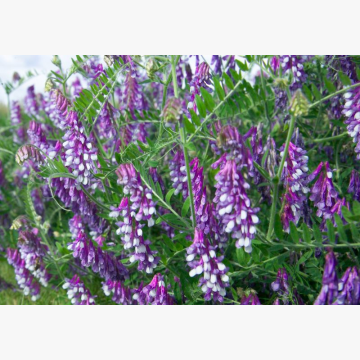- Home
- Seeds
- Winter cereals, etc.
- Hairy vetch
- Hairy vetch REA
FOR CONSULTATIONS APPLY TO:
Commercial director
Lina Smalskienė
tel. +370 618 02 551
e-mail linak@agrolitpa.lt
Sales manager
Tautvydas Kliučininkas
tel. +370 681 35 093
e-mail tautvydask@agrolitpa.lt
Sales manager
Eglė Petkevičienė
tel. +370 626 95 458
e-mail eglep@agrolitpa.lt
Sales manager
Kotryna Nakrošytė
tel.: +370 601 39 282
e-mail kotryna@agrolitpa.lt
Hairy vetch REA
A hairy vetch with good winter hardiness, resistance to diseases and extremely high yield of green mass
- High nutritional value
- Improves protein content of the spring green fodder
- Low soil requirements
- Sowed with rye or triticale does not require separate cultivation and fertilization
- Great for aftercrop
- Binds easily available nitrogen, which can be successfully used by post-harvest plants
- Rye vetch has more protein than common vetch
- Very high protein content – about 30 %
- Grows to a height of 1-1.5 meters
- Stem could be longer than 2 meters, weak, hangs on supporting plants
- Needs moisture at the beginning of growth
- Susceptible to drought, especially at the flower bud stage, as well as during flowering
- Very good resistance to cold
- Winters well and can withstand frosts of up to -20 °C with snow cover
- Very resistant to fungal diseases
- Hairy vetches differ from common vetches in that their entire plant is covered with dense hairs
- It is very undemanding to the soil and, due to its high protein content, is the first green fodder in the spring
- Rye vetch is suitable for growing in light, sandy and drier soils, efficiently uses moisture reserves accumulated in winter
- Cultivated in mixtures with rye and triticale, does not require fertilization and additional cultivation costs
- The seed yield of winter vetches, sown with a small proportion in the mixture with rye, varies from 300 kg to 800 kg per 1 ha
- The weight of 1000 grains – 35-48 g
- Hairy vetch overwinters and grows better in lighter soils, accumulates more nitrogen, so it goes well with rye
- Likes fertile (alkaline or neutral) and sunny, moderately moist soils
- Although the soil is ploughed early, sowing vetches with rye can be delayed until September-October
- For a better yield, vetch can be sown 2-3 weeks earlier than rye, but this method is effective and economical when growing elite seed
- In more fertile soils it is cultivated only as plant for green mass
- The deep root system of vetches prevents soil erosion
- Winter vetches can be grown as summer cover crops by sowing them in late July-early August, and the green crop can be harvested until frost
The varietal parameters may differ from those indicated here when the testing circumstances differ from quondam
Recommended sowing rate when growing for seeds: 60 kg/ha of vetch and 120 kg/ha of rye
Recommended sowing rate when growing for green fodder: 50-60 kg/ha of vetch and 80 kg/ha rye
In mixtures with oats – 100 kg/ha of vetch and 70-100 kg/ha oats
Sowing depth – 3 cm, interrow spacing – 12.5 cm
Keravos sreet. 17, Kerava,
LT-38 131 Panevėžys district, LITHUANIA
Enterprise's code 168598128
VAT code LT685981219
Tel. +370 615 11 315
E. mail info@agrolitpa.lt




.JPG)

